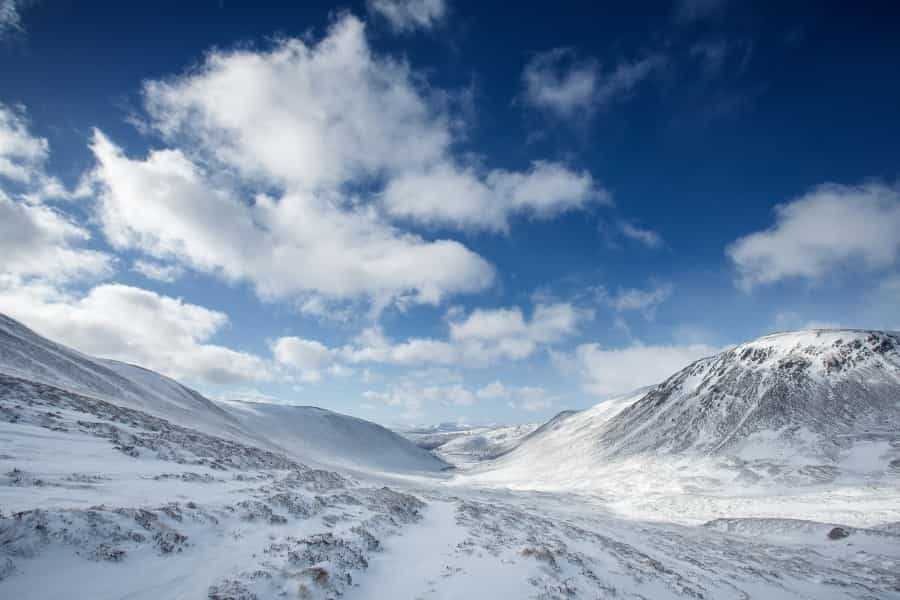Cairngorms Winter Sports

The Cairngorms’ winter sports resorts are some of the best places for skiing and snowboarding in the UK. Whether you’re a beginner or an experienced athlete, a day out here is sure to provide a challenge and plenty of thrills. But winter fun in the Cairngorms isn’t only about skiing. Alongside the lowdown on two of the region’s most popular winter sports centres, our guide to the best snowy activities in the national park also gives you tips on safety and choosing the right gear, as well as suggestions for some local hubs where you can try out more accessible activities like snowshoeing, sledging and cross-country skiing.
Skiing and snowboarding

Cairngorm Mountain
Open from December to April/May, Cairngorm Mountain’s ski resort is the most popular in the region. More than 18 miles (30 kilometres) of runs are serviced by 13 lifts, including a funicular railway that ferries skiers to the resort’s higher reaches. A SnowFactory and fan guns lend a hand when snow cover is limited.
A range of runs for skiers and snowboarders of all abilities includes two blacks and six reds. There are moguls and off-piste areas, as well as freestyle snowboarding areas with rails and jumps at Cas Shred and the Ptarmigan Park. More experienced skiers can also venture into the backcountry, but this is only advisable with careful preparation – always follow the Snowsports Touring Code.
For those who are learning, there’s a dedicated beginner zone, lessons are available (book in advance) and skis, snowboards, poles and helmets are available to rent.
Glenshee Ski Centre
Glenshee Ski Centre (open from December to the end of April) is the biggest in Scotland, with more than 25 miles (40 kilometres) of runs. It’s a great choice for both beginners and more proficient skiers, with extensive nursery slopes, 26 blue and red runs, and two blacks, including the legendary ‘Tiger’. They’re all linked by Britain’s largest lift system, which covers three valleys and four mountains and even includes a chairlift.
Snowboarders can take advantage of a natural half-pipe, steep slopes for freeriding and a freestyle park.
Equipment is available to rent, there’s a ski school for beginners (book in advance), and groups can hire private instructors. If you prefer something a little more gentle, with more time to experience the beauty of the mountains, the helpful staff at the Ski Centre are happy to offer advice on trails for ski touring and walking.
Tips for Cairngorms skiing
-
If you’re planning to go skiing in the Cairngorms, local weather conditions can make a big difference to which resort is the best on any given day. Check the weather forecast before you travel.
-
Disability Snowsport UK coordinates with both resorts to provide opportunities for adaptive snowsports too.

Cross-country skiing
Cross-country (or Nordic) skiing is a great way to get out and explore the Scottish countryside, and will certainly help to improve your fitness. As long as you wear the right clothes, cross-country skiing requires less equipment, you can try it anywhere where there’s some snow, and there’s no queuing for lifts.
If you like the idea of experiencing peace and quiet in the mountains, take a look at Glenmore Lodge. Eight miles from Aviemore and surrounded by pine forest, Scotland’s national centre for outdoor training has a piste machine that cuts trails through the forest in winter, and there’s a winter sports store on site where you can hire equipment. Contact them in advance to discuss lessons with an instructor. The trails here and around nearby Loch Morlich are largely flat, and good for beginners.
For those who are already experienced cross-country skiers, Trailmaps has produced a handy series of four maps with details of several trails within the national park.
Winter walking and hiking

With the right preparation, you can go walking and hiking in winter on many of the routes in the park that are so popular in summer, but you’re much more likely to have the trail to yourselves. The beauty of the snow-covered hills, mountains and forest in winter, the feeling of peace and solitude and the sense of achievement are hard to beat.
We’d advise starting out on (easier) local Community Paths and Heritage Trails before working your way up to hill tracks and sections of the park’s long-distance routes (such as the Speyside Way). Remember that when hiking, it’s essential to always bear in mind the capabilities of everyone in your group.
The National Park Authority walking page is an invaluable resource to help you choose where to go, with links to numerous maps and plenty of useful advice.
Here are a few basic tips for what to wear and how to stay safe.
Clothing
-
Wear sturdy walking boots and gaiters to keep your feet dry and comfortable.
-
Carry several layers of warm, weatherproof and breathable clothing that you can add or remove according to conditions.
-
Down jackets and proper ski gloves are particularly useful if there’s snow on the ground.
-
Wear a warm woollen hat and scarf to protect you from the wind and snow.
-
Wear warm and comfortable moisture-wicking socks, and carry a spare pair.
-
Sunglasses or even ski goggles will protect your eyes on bright snowy days.
-
Walking poles are great for extra balance and support.
-
Carry a waterproof bag or rucksack to protect your equipment and leave your hands free.
Safety tips:
-
Plan your route – carry maps of the area you plan to explore, and make sure you know how to read them. A smartphone with a GPS app is another good way to keep on the right track.
-
Check the weather – make sure you’re aware of the conditions on the day of your trip, and any approaching weather fronts.
-
Make sure that someone is aware of your chosen route, and when you plan to return.
-
Carry a first-aid kit, adequate food and water for the whole day, and a fully charged mobile phone in case of emergencies.
-
Always err on the side of caution – be careful around frozen areas of water, and stick to marked trails.
-
Start out slowly – try a few shorter walks before you embark on a day-long odyssey, so that you know what to expect from winter conditions.
While beautiful and exhilarating, winter hiking is not to be taken lightly. We’d heartily recommend visiting Glenmore Lodge’s excellent YouTube channel, home to a series of useful videos on how to prepare for winter walks, including what to pack, how to navigate, and preparing for unforeseen circumstances.
Ice climbing
Dare we say ‘niche’? Requiring mountaineering skills, crampons, ice axes and ropes, ice climbing is certainly not for the faint-hearted. Nonetheless, it’s a popular activity in the park, and while we wouldn’t presume to try and teach you here, we can certainly point you in the right direction. The Northern Corries – steep, north-facing glacial bowls that are easily accessible from the Cairngorms ski area – are the place to go.
Scotclimb’s short guide is a good starting point, while the UK Climbing Guide goes into more detail. Coire an t-Sneachda has routes suitable for beginners or experts, while Coire an Lochain’s steep cliffs have several more demanding options, The names of popular routes such as Satan’s Slit and Aladdin’s Mirror will give you a clue as to the near-mythical status of this adrenaline-fuelled sport.
Needless to say, safety, local knowledge and the correct equipment are paramount, and for that reason, whatever your level of experience, we’d definitely recommend hiring a local guide. Here are some places to contact:
Additional winter activities
Snowshoeing
Snowshoeing has provided a handy way of traversing deep snow for centuries, and a pair of snowshoes and some walking poles will provide you with access to any number of trails – flat or otherwise – that would be far more difficult to follow on foot. If you’d like to rent some snowshoes and try out this traditional method of travel, Aviemore’s outdoor equipment suppliers are a good place to start. Many of the winter sports resorts in the Cairngorms that we mention in this guide also offer snowshoe rental.
Sledging
When there’s a heavy snowfall, sledging is the simplest way of all to enjoy the thrill of speeding downhill, and it’s a good way for your kids to have fun and make friends too. You can try it out anywhere that there’s a decent slope, of course, but the thoughtful folk at Visit Cairngorms also provide a handy guide to the best sledging spots in the Cairngorms, from the Glenmore Forest Park and Rothiemurchus to the Strathspey Lawn in Aviemore. As an added bonus, lots of these have cafes nearby where you can stop for hot chocolate afterwards.
The Cairngorms’ winter sports centres and resorts provide a wealth of activities for both beginners and more experienced sports enthusiasts, from downhill and cross-country skiing to hiking, ice climbing and sledging. Provided you respect the winter weather and follow our safety guidelines, this beautiful park is a top choice for your next winter holiday.
We’d recommend booking accommodation, guides and equipment rental in advance, and sharing the photos and experiences of your trip on local social media channels so that everyone else can join in the fun (#VisitCairngorms/@VisitCairngorms).